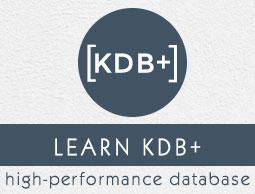Q Language - Dictionaries
Dictionaries are an extension of lists which provide the foundation for creating tables. In mathematical terms, dictionary creates the
“domain → Range”
or in general (short) creates
“key → value”
relationship between elements.
A dictionary is an ordered collection of key-value pairs that is roughly equivalent to a hash table. A dictionary is a mapping defined by an explicit I/O association between a domain list and a range list via positional correspondence. The creation of a dictionary uses the "xkey" primitive (!)
ListOfDomain ! ListOfRange
The most basic dictionary maps a simple list to a simple list.
| Input (I) |
Output (O) |
| `Name |
`John |
| `Age |
36 |
| `Sex |
“M” |
| Weight |
60.3 |
q)d:`Name`Age`Sex`Weight!(`John;36;"M";60.3) / Create a dictionary d
q)d
Name | `John
Age | 36
Sex | "M"
Weight | 60.3
q)count d / To get the number of rows in a dictionary.
4
q)key d / The function key returns the domain
`Name`Age`Sex`Weight
q)value d / The function value returns the range.
`John
36
"M"
60.3
q)cols d / The function cols also returns the domain.
`Name`Age`Sex`Weight
Lookup
Finding the dictionary output value corresponding to an input value is called looking up the input.
q)d[`Name] / Accessing the value of domain `Name
`John
q)d[`Name`Sex] / extended item-wise to a simple list of keys
`John
"M"
Lookup with Verb @
q)d1:`one`two`three!9 18 27
q)d1[`two]
18
q)d1@`two
18
Operations on Dictionaries
Amend and Upsert
As with lists, the items of a dictionary can be modified via indexed assignment.
d:`Name`Age`Sex`Weight! (`John;36;"M";60.3)
/ A dictionary d
q)d[`Age]:35 / Assigning new value to key Age
q)d
/ New value assigned to key Age in d
Name | `John
Age | 35
Sex | "M"
Weight | 60.3
Dictionaries can be extended via index assignment.
q)d[`Height]:"182 Ft"
q)d
Name | `John
Age | 35
Sex | "M"
Weight | 60.3
Height | "182 Ft"
Reverse Lookup with Find (?)
The find (?) operator is used to perform reverse lookup by mapping a range of elements to its domain element.
q)d2:`x`y`z!99 88 77
q)d2?77
`z
In case the elements of a list is not unique, the find returns the first item mapping to it from the domain list.
Removing Entries
To remove an entry from a dictionary, the delete ( _ ) function is used. The left operand of ( _ ) is the dictionary and the right operand is a key value.
q)d2:`x`y`z!99 88 77
q)d2 _`z
x| 99
y| 88
Whitespace is required to the left of _ if the first operand is a variable.
q)`x`y _ d2 / Deleting multiple entries
z| 77
Column Dictionaries
Column dictionaries are the basics for creation of tables. Consider the following example −
q)scores: `name`id!(`John`Jenny`Jonathan;9 18 27)
/ Dictionary scores
q)scores[`name] / The values for the name column are
`John`Jenny`Jonathan
q)scores.name / Retrieving the values for a column in a
/ column dictionary using dot notation.
`John`Jenny`Jonathan
q)scores[`name][1] / Values in row 1 of the name column
`Jenny
q)scores[`id][2] / Values in row 2 of the id column is
27
Flipping a Dictionary
The net effect of flipping a column dictionary is simply reversing the order of the indices. This is logically equivalent to transposing the rows and columns.
Flip on a Column Dictionary
The transpose of a dictionary is obtained by applying the unary flip operator. Take a look at the following example −
q)scores
name | John Jenny Jonathan
id | 9 18 27
q)flip scores
name id
---------------
John 9
Jenny 18
Jonathan 27
Flip of a Flipped Column Dictionary
If you transpose a dictionary twice, you obtain the original dictionary,
q)scores ~ flip flip scores
1b


